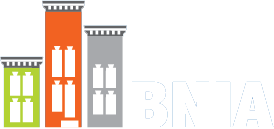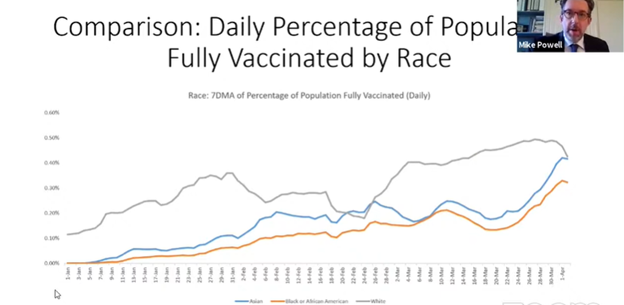By: Hannah Boyd – (Data Science Corps Fellow, Spring 2021)
The last year has been a tough and stressful time for many people. Luckily, there are finally a few different vaccines available for COVID-19, and with any luck, the world will be able to move on soon. However, that counts on everybody being able to access a vaccine that works, but the distribution of the vaccines varies depending on certain factors. As part of my Data Science Corps Fellowship, I worked with the Office of the Baltimore City Council President to study the distribution of COVID-19 vaccines in Baltimore City as well as how to possibly address the inequities in said distribution.
Baltimore City has seen its share of troubling times, and this pandemic has only added on to that. For this study, I looked at updates for Maryland’s COVID-19 vaccine plan and several related dashboards. I also attended weekly meetings with the Baltimore City Health Department and the Vaccine Oversight Work Group. Baltimore City has additional things to consider compared to other jurisdictions, such as senior care, hospitals, and poverty that prevents travel and proper hospital care. As of April 19, the city is in Phase 1, has an overall population of 575,584 people, and despite the fact the vaccine came out several weeks ago, only 194,556 residents have their first dose, and 125,287 have been fully vaccinated as of April 19. It also looks like the projected allocations are starting to drop; weeks 17-20 were previously estimated to have 5,700 doses, now only having an estimated amount of 3,900 doses as of week 18.
While looking at the data each week, I was surprised to learn that residents of the city are now only receiving close to 35% of the vaccinations (first or single dose), the most obvious reason for this being citizens of other jurisdictions coming to the city to get their vaccinations. This means the majority of the allocations aren’t going to the residents, which understandably slows down any progress the city makes. It could also be responsible for the fourth wave the city has experienced. Similar counties such as Prince George’s county have also seen a small portion of their allocations going to local residents, and a few Federally Qualified Health Care centers haven’t been given allocations. With the Johnson & Johnson vaccine being put on hold, the city has even less to work with, and it’s doubtful it will be trusted if it is returned.
Below is a graph from the Baltimore City COVID-19 Dashboard showing the progression of the city’s vaccinations as of April 19. The rate of vaccinations is fairly consistent, however the rate goes up near the end of March
Source: https://baltimore.maps.arcgis.com/apps/dashboards/4b64b6e8c0014b6998d767fcf077bfaf
More women have been fully, or partially vaccinated, 35.7% having their first/single dose, and 23.8% being fully vaccinated, two thirds of the vaccine recipients in Maryland as of April 5 were also women. (Senate Vaccine Oversight Workgroup (4/5/2021), 2021) The first or single dose percentages outweigh the fully vaccinated percentages for all ages. Less African Americans have been fully vaccinated than Caucasians in the city, however more have received their first/single dose as of April 19, and less Latinx residents have also received their vaccinations. (Baltimore City COVID-19 Vaccination Dashboard, n.d.) Considering African Americans make up 63% of the city’s population, and Latinx residents total 5%, this explains why less than half of the city is fully, or partially vaccinated. Part of it comes from the fact that people who aren’t residents are taking most of the allocations, other parts of it come from the residents being unable to access them, and the rest of it is a lack of trust in the healthcare system. Both populations need these vaccines as soon as possible, since they also make up the majority of the COVID-19 cases and deaths in the city. The council president was one of the first to address these racial distribution inequities.
The Senate Vaccine Oversight Committee has also noticed the disparities in the distribution of vaccines in Maryland, providing the chart below on April 5.
Mobile vaccine clinics are being deployed to get the vaccines to some of the older residents, as well as others who are less likely to have access to transportation, or any means of getting a vaccine by themselves. (Senate Vaccine Oversight Workgroup (3/29/2021), 2021) Whether the residents trust the COVID-19 vaccine is a different story. Looking back on America’s history, it’s easy to see why minority groups would be hesitant to trust healthcare professionals, as nobody wants to end up being an unwilling test subject. The fact that less people who are Hispanic or Latino have taken the vaccination also emphasizes the lack of trust from people of color, and the distrust was repeatedly mentioned on the news. However, as mentioned by Dr. Nicolette Louissaint from the Town Hall meeting, for some it’s not so much they don’t want to take it, as it is that they don’t want to take it first. This means there could be an increase in vaccination numbers for people of color once they feel it’s actually safe to take it, and it would account for why things appear to be speeding up, and more African Americans now have their first/single doses. Even for those who do want a vaccination, and have access to the internet to try and set up an appointment, there may still be problems. Some keep getting error messages, such as “web not found”, or if there appears to be a time slot open, it goes away the second it’s clicked on. Those websites need to be fixed if they actually want people to be able to make appointments.
Delivering vaccinations directly to the neighborhoods would be a good way of making sure everybody in the community gets a shot. That way, people don’t need internet access to make appointments, and don’t have to worry about a site running out of vaccines when they’re in the middle of the line. Having other people of color administer the shots may also provide some comfort, or just a sense of security while receiving the shot. It also guarantees that residents are the ones receiving the vaccines, since the projected allocations to the Baltimore City Health Department appear to be dwindling for now. Zip codes with the highest number of cases should be visited first, and considered a high priority. Some examples of these areas are 21226 and 21205, in the Baltimore city metro area, which have positivity rates of 10% or more, and the University of Maryland Medical System has stated that they are in fact going to prioritize residents that have registered for the vaccine in certain zip codes once schedules open. (Mosby, 2021)
For residents that would have an easier time getting to a vaccination site, or if collecting people and dropping them off at a vaccination site is easier than delivering the vaccines directly to them, there needs to be more funding and resources for a mass vaccination site or two in the city. Directly getting the vaccines to every person in every neighborhood may be a little difficult, especially due to requirements needed to keep the vaccines usable, so the sites may need to bring the people to them.
Bibliography
Baltimore City COVID-19 Vaccination Dashboard. (n.d.). Retrieved April 19, 2021, from https://baltimore.maps.arcgis.com/apps/dashboards/4b64b6e8c0014b6998d767fcf077bfaf
Mosby, N. J. (2021, April 13). COVID-19 Townhall with Council President Nick J. Mosby. Facebook. Retrieved April 19, 2021, from https://www.facebook.com/BaltCouncil/videos/169151491727159/
Senate Vaccine Oversight Workgroup (3/29/2021). (2021, March 29). Maryland General Assembly.
https://mgaleg.maryland.gov/mgawebsite/Committees/Media/false?cmte=vow&cli
p=VOW_3_29_2021_meeting_1&ys=2021rs
Senate Vaccine Oversight Workgroup (4/5/2021). (2021, April 5). Maryland General Assembly. Retrieved April 5, 2021, from https://mgaleg.maryland.gov/mgawebsite/Committees/Media/false?cmte=vow&clip=VOW_4_5_2021_meeting_1&ys=2021rs




